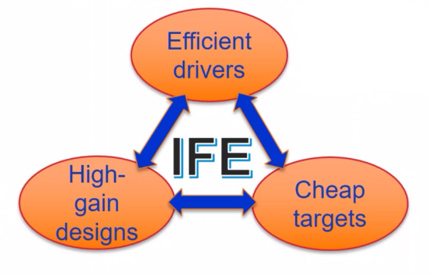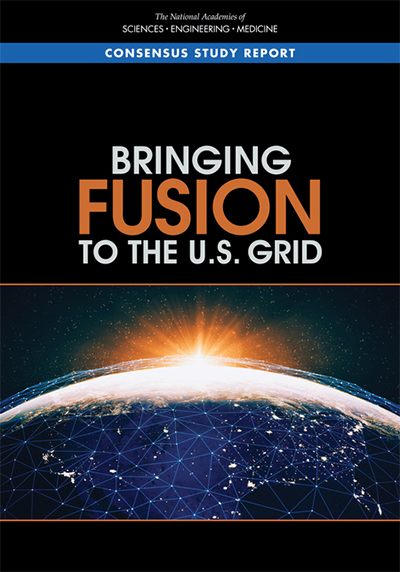Workshop Examines Prospects, Challenges for Inertial Fusion Energy
Excitement and optimism tempered by warnings against unrealistic expectations were the primary themes emerging from last month’s LLNL-sponsored workshop on the potential use of inertial confinement fusion (ICF) to generate commercially viable inertial fusion energy (IFE).
The virtual workshop, held from Feb. 22-24, was inspired by a number of national reports recommending the reestablishment of a national IFE program and the results of the milestone Aug. 8, 2021, NIF ICF experiment that produced 1.35 megajoules of energy. That experiment moved NIF to the threshold of ignition—when the fusion energy generated is equal to or greater than the amount of laser energy delivered to the target (see How NIF Works).
 Graphic summarizing some of the major requirements of an inertial fusion energy reactor. Credit: Valeri Goncharov, Laboratory for Laser Energetics (LLE), University of Rochester
Graphic summarizing some of the major requirements of an inertial fusion energy reactor. Credit: Valeri Goncharov, Laboratory for Laser Energetics (LLE), University of Rochester LLNL physicist Alex Zylstra, chief experimentalist for the Aug. 8 experiment and organizer of the workshop, said its purpose was to assess near- and long-term research opportunities in IFE and the necessary high energy density (HED) physics and technologies, and to outline and develop a strategy for the HED physics, ICF, and IFE communities to work together.
“This workshop endeavors to collect input from the entire community,” Zylstra said, “spanning academia, national laboratories, industry, and private investors. Engaging all aspects of our community and leveraging their unique capabilities solidifies the foundation of future IFE work.”
 Recent reports by the national academies and an influential DOE advisory committee have recommended stepped-up U.S. investments in fusion energy.
Recent reports by the national academies and an influential DOE advisory committee have recommended stepped-up U.S. investments in fusion energy. About 200 IFE researchers and supporters participated, submitting 83 white papers, making 19 presentations and plenary talks, and brainstorming ideas in five breakout sessions. The workshop covered the role of government agencies and the private sector in pursuing IFE; methods of driving, or compressing, the fusion fuel; target physics and fabrication; engineering challenges in designing an IFE power plant; and a development pathway, such as constructing a test facility to assess the various approaches to IFE and determine the most promising path forward.
The participants also discussed the need to expand diversity in the IFE field, develop the future workforce, and instill public confidence in the benefits of fusion energy.
Zylstra said the information developed in the workshop will be gathered into a report to be submitted to a Department of Energy (DOE) Office of Science-sponsored IFE Basic Research Needs (BRN) workshop scheduled for early May. The DOE and the White House Office of Science and Technology have also scheduled a summit, “Developing a Bold Decadal Vision for Commercial Fusion Energy,” for March 17.
Kramer Akli, program manager in DOE’s Fusion Energy Sciences (FES) program, said the BRN “is expected to provide FES with a set of priority research opportunities that can inform future research efforts in IFE and build a community of next-generation researchers in this area.” An important element of the BRN’s charge, he said, will be to “assess the role of the private sector, including public-private partnerships, in a national IFE program.”While FES is the primary federal sponsor for fusion research, other agencies have made important investments, including the DOE Advanced Research Project Agency-Energy (ARPA-E), DOE Advanced Scientific Computing Research (ASCR), and the National Nuclear Security Administration (NNSA). Along with Akli, representatives of ARPA-E and NNSA gave talks to open the workshop.
The participants praised NIF’s accomplishment and expressed enthusiasm for IFE’s potential to provide a safe, clean, and virtually inexhaustible source of energy to help meet the planet’s growing energy needs while combatting climate change.
“The U.S. currently has a significant world lead in Inertial Confinement Fusion due to the large investment by NNSA. This should be leveraged to build an IFE program that offers a distinctly different and potentially attractive path to fusion energy.”
—A Community Plan for Fusion Energy and Discovery Plasma Sciences, American Physical Society Division of Plasma Physics
They also recognized the many challenges that lie ahead, such as developing efficient drivers capable of achieving net energy gain (more energy produced than the energy required to operate an IFE reactor); firing the driver at a rate of 10 Hz (10 times a second) or more to provide a continuous stream of energy to the power plant; mass-producing millions of inexpensive targets; and developing materials able to withstand the reactor’s intense radiation environment.
Omar Hurricane, chief scientist for the Laboratory’s ICF program, and LLNL physicists Zylstra, Debbie Callahan, and Annie Kritcher sounded a cautionary note in a white paper and presentation titled, “Optimism is not a strategy: how to give IFE a fighting chance to be real.”
“It is important to recognize that ignition on the NIF has been much more difficult than what was originally envisioned,” the researchers said. “In order to avoid squandering time and resources, the IFE community must learn the lessons of what happened on the NIF over the past decade (see “Pursuing Ignition: A Decade of Progress”). Only by facing reality and acknowledging all the challenges can we identify and solve the issues that stand in the way of practical fusion energy.”
“The workshop was informative and engaging,” Akli said at the conclusion. “This is an excellent start to the community, and we look forward to the next steps for an IFE program roadmap.”
Joining Zylstra in organizing the workshop were LLNL business specialist MariAnn Albrecht and LLNL web designer Jason Laurea. The Steering Committee for the workshop included Mike Campbell of LLE, Mark Herrmann of LLNL, Mike Cuneo of Sandia National Laboratories, Cameron Geddes of Lawrence Berkeley National Laboratory (LBNL), Steve Obenschain of the Naval Research Laboratory (NRL), Mike Dunne of SLAC National Accelerator Laboratory, Mike Farrell of General Atomics (GA), and Jeff Latkowski of TerraPower. The Program Committee consisted of Wayne Meier of LLNL (retired), Ryan McBride of the University of Michigan, Radha Bahukutumbi of LLE, Peter Seidl of LBNL, Lin Yin of Los Alamos National Laboratory, Matt Wolford of NRL, and Neil Alexander of GA.
More Information
“Milestone Shot Enhances Future of Stockpile Stewardship and Fusion Energy Science,” NIF & Photon Science News, February 15, 2022
“Self-heating plasmas offer hope for energy from fusion,” Nature, January 26, 2022
“Reports Recommend Stepped-Up U.S. Investment in Fusion Energy,” NIF & Photon Science News, March 8, 2021
Powering the Future: Fusion & Plasmas (PDF download), Fusion Energy Science Advisory Committee, December, 2020
Plasma Science: Enabling Technology, Sustainability, Security, and Exploration, National Academies of Sciences, Engineering, and Medicine, May, 2020
A Community Plan for Fusion Energy and Discovery Plasma Sciences, (PDF download) American Physical Society Division of Plasma Physics, March, 2020
—Charlie Osolin
Follow us on Twitter: @lasers_llnl



